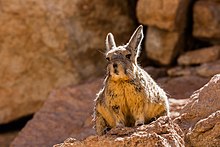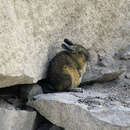Lifespan, longevity, and ageing
provided by AnAge articles
Maximum longevity: 19.5 years (captivity)
- license
- cc-by-3.0
- copyright
- Joao Pedro de Magalhaes
- editor
- de Magalhaes, J. P.
Conservation Status
provided by Animal Diversity Web
Populations are declining due to hunting by local peoples.
CITES: no special status
IUCN Red List of Threatened Species: least concern
- license
- cc-by-nc-sa-3.0
- copyright
- The Regents of the University of Michigan and its licensors
- bibliographic citation
- Shefferly, N. 1999. "Lagidium viscacia" (On-line), Animal Diversity Web. Accessed April 27, 2013 at http://animaldiversity.ummz.umich.edu/site/accounts/information/Lagidium_viscacia.html
- editor
- Nancy Shefferly, Animal Diversity Web
Morphology
provided by Animal Diversity Web
Like all members of this family, viscachas have thick, soft pelage, except on their tails where it is coarse. They have pale yellow or grey upper parts, and a black tail tip. Overall, viscachas look like rabbits. They have long, fur covered ears, edged with a fringe of white fur. All feet have four digits. The enamal of the incisors is not colored.
Range mass: 3.000 (high) kg.
Other Physical Features: endothermic ; bilateral symmetry
- license
- cc-by-nc-sa-3.0
- copyright
- The Regents of the University of Michigan and its licensors
- bibliographic citation
- Shefferly, N. 1999. "Lagidium viscacia" (On-line), Animal Diversity Web. Accessed April 27, 2013 at http://animaldiversity.ummz.umich.edu/site/accounts/information/Lagidium_viscacia.html
- editor
- Nancy Shefferly, Animal Diversity Web
Life Expectancy
provided by Animal Diversity Web
Average lifespan
Status: captivity: 19.5 years.
- license
- cc-by-nc-sa-3.0
- copyright
- The Regents of the University of Michigan and its licensors
- bibliographic citation
- Shefferly, N. 1999. "Lagidium viscacia" (On-line), Animal Diversity Web. Accessed April 27, 2013 at http://animaldiversity.ummz.umich.edu/site/accounts/information/Lagidium_viscacia.html
- editor
- Nancy Shefferly, Animal Diversity Web
Habitat
provided by Animal Diversity Web
Viscachas inhabit rugged, rocky mountanous country with sparse vegetation.
Terrestrial Biomes: mountains
- license
- cc-by-nc-sa-3.0
- copyright
- The Regents of the University of Michigan and its licensors
- bibliographic citation
- Shefferly, N. 1999. "Lagidium viscacia" (On-line), Animal Diversity Web. Accessed April 27, 2013 at http://animaldiversity.ummz.umich.edu/site/accounts/information/Lagidium_viscacia.html
- editor
- Nancy Shefferly, Animal Diversity Web
Distribution
provided by Animal Diversity Web
The mountain viscacha is found in the extreme southern portion of Peru, Western and Central Bolivia, Northern and Central Chile, and in Western Argentina.
Biogeographic Regions: neotropical (Native )
- license
- cc-by-nc-sa-3.0
- copyright
- The Regents of the University of Michigan and its licensors
- bibliographic citation
- Shefferly, N. 1999. "Lagidium viscacia" (On-line), Animal Diversity Web. Accessed April 27, 2013 at http://animaldiversity.ummz.umich.edu/site/accounts/information/Lagidium_viscacia.html
- editor
- Nancy Shefferly, Animal Diversity Web
Trophic Strategy
provided by Animal Diversity Web
Mountain viscachas are reputed to eat just about any plant they encounter. Their diet is principally composed of grasses, mosses and lichens.
Primary Diet: herbivore (Folivore )
- license
- cc-by-nc-sa-3.0
- copyright
- The Regents of the University of Michigan and its licensors
- bibliographic citation
- Shefferly, N. 1999. "Lagidium viscacia" (On-line), Animal Diversity Web. Accessed April 27, 2013 at http://animaldiversity.ummz.umich.edu/site/accounts/information/Lagidium_viscacia.html
- editor
- Nancy Shefferly, Animal Diversity Web
Benefits
provided by Animal Diversity Web
Mountain viscachas are hunted for both meat and fur.
Positive Impacts: food ; body parts are source of valuable material
- license
- cc-by-nc-sa-3.0
- copyright
- The Regents of the University of Michigan and its licensors
- bibliographic citation
- Shefferly, N. 1999. "Lagidium viscacia" (On-line), Animal Diversity Web. Accessed April 27, 2013 at http://animaldiversity.ummz.umich.edu/site/accounts/information/Lagidium_viscacia.html
- editor
- Nancy Shefferly, Animal Diversity Web
Behavior
provided by Animal Diversity Web
Perception Channels: tactile ; chemical
- license
- cc-by-nc-sa-3.0
- copyright
- The Regents of the University of Michigan and its licensors
- bibliographic citation
- Shefferly, N. 1999. "Lagidium viscacia" (On-line), Animal Diversity Web. Accessed April 27, 2013 at http://animaldiversity.ummz.umich.edu/site/accounts/information/Lagidium_viscacia.html
- editor
- Nancy Shefferly, Animal Diversity Web
Reproduction
provided by Animal Diversity Web
Mating occurs from October through December. After a gestation of 120-140 days, a female gives birth to a single, precocious young. The young are born fully furred, with their eyes open, and are able to eat solid food on their first day of life. Nursing continues for eight weeks. Females are remarkable for the large number of ova they ovulate (around 300) during each estrus period.
Range number of offspring: 1.000 to 2.000.
Range gestation period: 120 to 135 days.
Range weaning age: 56 (high) days.
Key Reproductive Features: gonochoric/gonochoristic/dioecious (sexes separate); sexual
Average birth mass: 260 g.
Average number of offspring: 1.5.
Parental Investment: precocial
- license
- cc-by-nc-sa-3.0
- copyright
- The Regents of the University of Michigan and its licensors
- bibliographic citation
- Shefferly, N. 1999. "Lagidium viscacia" (On-line), Animal Diversity Web. Accessed April 27, 2013 at http://animaldiversity.ummz.umich.edu/site/accounts/information/Lagidium_viscacia.html
- editor
- Nancy Shefferly, Animal Diversity Web
Biology
provided by Arkive
During the day, the southern viscacha emerges from the clefts and crevices it colonises, to forage for food, and bask on rocky perches in the sun (1) (3) (4). It runs and leaps amongst the rocks with incredible agility, and eats a wide variety of plants including grasses, mosses, and lichens (3) (4).
Like all mountain viscachas, the southern viscacha is a gregarious species that forms small to very large colonies, comprising one or more family groups (4) (5). The timing of the breeding season is not documented for this species, but the gestation period has been estimated at 120 to 140 days, with just a single young born at a time. The young is born fully haired with its eyes open, and is normally weaned after eight weeks, and reaches sexual maturity at around a year (3).
Conservation
provided by Arkive
There are currently no known conservation measures in place for the southern viscacha, but it does occur in several protected areas. Although hunting is not currently considered a major threat to this species, it needs to be monitored in case it starts to have a severe impact on the population (1).
Description
provided by Arkive
The southern viscacha is one of three South American rodent species commonly referred to as mountain viscachas (3) (4). In common with its two congeners, the southern viscacha looks remarkably like a long-tailed rabbit (3). Soft dense fur covers its body, from the tips of its elongate ears to the end of its long, curled tail (2) (3). The forelimbs are relatively short, while the contrastingly long and muscular hind-limbs enable it run and jump with ease (3) (4). The colour of its fur varies seasonally and with age, but generally the upperparts are grey to brown, with tints of cream and black, while the under-parts are pale yellow or tan (2).
Habitat
provided by Arkive
Restricted to sparsely vegetated, rocky habitats, from 2,500 metres to 5,100 metres above sea level (1) (3).
Range
provided by Arkive
The southern viscacha has a patchy distribution comprising parts of western Bolivia, northern Chile, western Argentina and possibly extreme southern Peru (1) (3).
Status
provided by Arkive
Classified as Least Concern (LC) on the IUCN Red List (1).
Threats
provided by Arkive
Although the southern viscacha is locally hunted for its meat and fur, it is still a very common species, and is not thought to be declining at a rate to warrant significant concern (1).
Southern viscacha
provided by wikipedia EN
The southern viscacha (Lagidium viscacia) is a species of viscacha, a rodent in the family Chinchillidae found in Argentina, Bolivia, Chile, and Peru. It is a colonial animal living in small groups in rocky mountain areas. It has long ears and hind legs and resembles a rabbit in appearance apart from its long, bushy tail, but is not a lagomorph.
Description
The southern viscacha has yellowish-grey upperparts, paler underparts, and a black-tipped, bushy tail. The body fur is long and soft, while that on the tail is coarse. The long, fur-covered ears have a white fringe and both the short front legs and longer hind legs have four digits on the feet. The soles of the feet have fleshy pads called "pallipes" and they can move about with agility over rocky surfaces. The weight of an adult southern viscacha is about 3 kg (6.6 lb).[2][3]
Distribution and habitat

Range of the southern viscacha.
The southern viscacha is native to the mountainous parts of western Argentina, southern Peru, western and central Bolivia, and northern and central Chile. It lives among rocks and around crags where the vegetation is sparse.[2] Its elevation range is about 700 to 5,100 m (2,300 to 16,700 ft) above sea level.[1]
Behaviour
The southern viscacha does not hibernate and is mostly active soon after dawn and again in the evening. At these times, it emerges from its underground hiding place to feed on what plant material is available, which is mostly grasses and moss, and it also eats lichens. Part of the day is spent perched on a rock sunbathing, grooming, or resting. Southern viscachas are a colonial species and do not venture far from rocks so that they can plunge underground if danger threatens. They use various calls to communicate with each other.[2][3] They are preyed on by the Andean mountain cat (Leopardus jacobitus) and they form a substantial part of its diet.[4]
Breeding starts in the last quarter of the year when mating takes place. The gestation period is about 130 days and a single precocial pup (or sometimes two) is born which has its eyes open and is fully clad in fur at birth. It suckles for about eight weeks, but is able to supplement the milk with solid food within hours of its birth. The average lifespan is unknown, but one individual survived for 19 years in captivity.[2]
Status

Southern viscacha (
Lagidium viscacia), Siloli desert, Bolivia
The southern viscacha is a common species and locally abundant, but it is prone to wide swings in population due to adverse weather conditions. It is hunted for its flesh and its fur, but not to such an extent as to reduce its numbers significantly. The IUCN lists it as being of Least Concern.[1]
References
-
^ a b c Bernal, N. (2016). "Lagidium viscacia". IUCN Red List of Threatened Species. 2016: e.T11148A22190789. doi:10.2305/IUCN.UK.2016-2.RLTS.T11148A22190789.en. Retrieved 17 November 2021.
-
^ a b c d Shefferly, Nancy (1999). "Lagidium viscacia: southern viscacha". Animal Diversity Web. University of Michigan. Retrieved 2013-10-04.
-
^ a b Myers, Phil (2002). "Chinchillidae: chinchillas and viscachas". Animal Diversity Web. University of Michigan. Retrieved 2013-10-04.
-
^ Walker, R. Susan; Novaro, Andrés J.; Perovic, Pablo; Palacios, Rocio; Donadio, Emiliano; Lucherini, Mauro; Pia, Mónica; López, María Soledad (2007). "Diets of three species of Andean carnivores in high-altitude deserts of Argentina". Journal of Mammalogy. 88 (2): 519–525. doi:10.1644/06-MAMM-A-172R.1.

- license
- cc-by-sa-3.0
- copyright
- Wikipedia authors and editors
Southern viscacha: Brief Summary
provided by wikipedia EN
The southern viscacha (Lagidium viscacia) is a species of viscacha, a rodent in the family Chinchillidae found in Argentina, Bolivia, Chile, and Peru. It is a colonial animal living in small groups in rocky mountain areas. It has long ears and hind legs and resembles a rabbit in appearance apart from its long, bushy tail, but is not a lagomorph.
- license
- cc-by-sa-3.0
- copyright
- Wikipedia authors and editors

